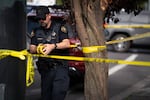
Portland police cordon off a neighborhood after a shooting in this August 2021 file photo.
Jonathan Levinson / OPB
Portland city officials last week quietly reversed course on a decision to avoid a competitive bid process and launch a gunshot detection pilot program with ShotSpotter, a company critics say dramatically oversells its capabilities.
Portland Director of Community Safety Stephanie Howard notified the Focused Intervention Team Community Oversight Group of the decision during the group’s Jan. 5 meeting.
“There have been other vendors who have expressed an interest in providing a proposal to the city on technology like Shotspotter… acoustic gunshot detection technology,” Howard told the oversight group. “We at the city are going to put out a request for proposals so that everyone has a fair shot at making their pitch for why their technology would be the best for a pilot.”
Portland Mayor Ted Wheeler initially greenlit the ShotSpotter pilot after the oversight group issued a 60-page report last July recommending the technology. The report leaned heavily on ShotSpotter funded research in completing its analysis.
Wheeler did not respond to emails asking what prompted the new approach.
Reporting by OPB also showed how ShotSpotter sales representatives cultivated close relationships with Portland police leadership. According to the oversight group’s chairperson, it was PPB “captains and lieutenants” who first suggested the group look into ShotSpotter and then helped usher the company through the sales process.
Portland Police Capt. James Crooker helped ShotSpotter Western Region director Terri Greene prepare her presentation for the oversight group and city officials.
The original plan came despite public records showing a ShotSpotter competitor had spent months trying to get city officials to consider their technology as well.
After not responding to several emails this fall, Howard told EAGL technology’s Joe Swan the city was not in a position to partner with them at this time.
“If that changes in the future, we will be sure to reach out,” she wrote in a November email.
Instead of relying on microphones like ShotSpotter, EAGL’s detection technology, which was developed by the U.S. Department of Energy, senses the energy waves produced by a bullet moving through the air. The company says that means their sensors are far more reliable and won’t mistake loud noises like jackhammers or backfiring cars for gunshots, a common complaint from cities which have stopped using ShotSpotter.
ShotSpotter claims to have a 97% accuracy rate and a 0.5% false positive rate but other cities have failed to replicate those results. The San Diego police said that after 584 ShotSpotter alerts over four years, the department only made two arrests responding to ShotSpotter calls.
In a May email to Crooker, Portland Police Bureau Deputy Chief Mike Frome said Police Chief Chuck Lovell had heard numerous complaints from fellow chiefs in other cities. Frome said among those concerns was that ShotSpotter “will drive up calls for service for false alarms.”
Jonathan Manes, an attorney at the MacArthur Justice Center who has researched ShotSpotter said there has never been a study testing how easily or frequently ShotSpotter is triggered by noises that aren’t gunshots.
“The system has been on the market for more than 20 years and there is no published study or testing,” Manes told a Jan. 6 meeting of the Interfaith Peace and Action Collaborative, a community group working to address gun violence. “This is a really serious problem because everytime ShotSpotter triggers an alert, police are going out believing being told that they should expect to find somebody who is armed and potentially dangerous.”
But, Manes said, the reality is police don’t find evidence of gunfire on 90% of the ShotSpotter alerts they respond to.
“ShotSpotter… starts from an assumption that it’s 100% accurate,” Manes said. “And the only time it counts something as an error, is if the police department voluntarily sends a complaint to ShotSpotter, that ShotSpotter got it wrong and then ShotSpotter agrees that it got it wrong.”
ShotSpotter pushed back on MacArthur’s research in a November email to OPB.
“The MacArthur Justice Foundation has purposely confused reports of lower immediate physical evidence recovery rates after an alert to mean there was no gunfire,” Sam Klepper, Senior Vice President of Marketing & Product Strategy, wrote in an email. “However, linking an alert with evidence of a shooting can be challenging as some guns do not eject casings and those that do can eject haphazardly. In addition, a high number of alerts happen late at night making evidence collection difficult as well as engaging witnesses.”
Howard told the oversight group a request for proposals is expected to be posted in the next two weeks and then stay open for two weeks. The city will then narrow the pool to the top two submissions and the public will have a chance to offer input.
“Part of that process will include… a town hall and to invite feedback from the community, so that the vendors themselves can… present their proposals to the public and they can answer questions directly,” Howard said.
She said she hopes the 12-month pilot will begin in March.
